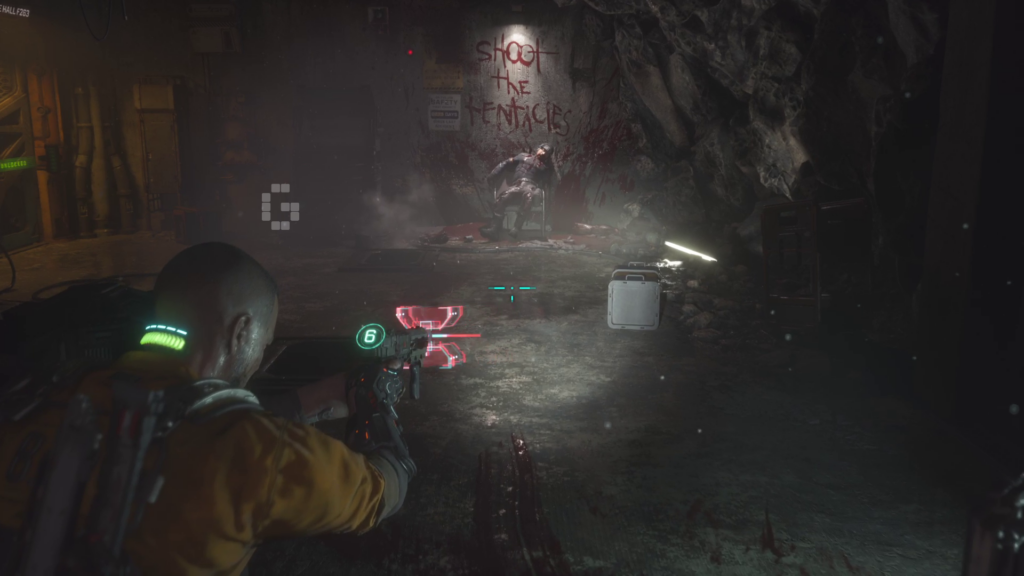The Callisto Protocol has a unique kind of promise to it- with Dead Space inexplicably in its DNA and Hollywood making up the rest of it, it feels like a game that’s trying to bring the true prestige triple-A Survival Horror experience.
I mean it’s not like triple-A survival horror doesn’t exist- just look at Dead Space 2 or even the very excellent Resident Evil Village. That level of resource allocation totally makes for a great horror experience. But when you get to that prestige level- one of needing to sell theatrics and drama, does survival horror of all things actually need that?
And even once you abandon that question, you’re left with a more upfront one: is The Callisto Protocol any good?
Unfavorable Comparisons
I really tried to get through the Callisto Protocol without comparing it to Dead Space, but the game doesn’t let you. From its similar design language (your HUD is baked into your character rather than the screen) to its premise (a remote location is overrun by a weird body horror zombie infestation, probably caused by the people in charge), you have no choice but to acknowledge the brief for this game was probably along the lines of “Make us a Dead Space but for Krafton”.
Despite being helmed by Dead Space co-creator Glen Schofield, it definitely feels like The Callisto Protocol has a fundamental misunderstanding of what was so great about those games. If they literally wanted to make their own “spiritual successor” to EA’s dead-then-not franchise I don’t think anyone would have been mad for it- instead what we get is something that feels like it started out as Dead Space but then was viciously snapped away in fear of lawyers getting involved.

You see this most in the game’s enemies- While Dead Space had the excellently designed Necromorphs- true emblems of the body horror moniker- The Callisto Protocol’s enemies are just generic zombies with at most two heads to make them extra spooky. It feels like no particular thought went into how to make them unique or clever, or even translate it into meaningful combat information.
You can shoot off their limbs, sure. But you don’t need to. In fact the game’s combat system basically discourages any kind of precision shooting, since it primarily wants you to be doing your shots as combo enders for your melee, which feature a snap to doing headshots.
The worst feeling is that the game has realized its enemy design is lackluster. You’re soon introduced to Mutations- now the zombies will occasionally sprout tentacles, which you’ll need to shoot to stop them from mutating. Mutate into what, you ask? A bigger zombie with the same generic moveset.

It’s kind of emblematic of my whole disappointment with The Callisto Protocol- it constantly feels like it’s going to blow you away with some genius implementation, then it just… doesn’t. At one point in the game you’re brought to an underground colony, full of enemies who will only react to sound- it’s a clever enough idea, but the fact that they’re literally the same enemies you’ve always fought with a slightly crustier texture over them and significantly larger in number so you’ll use the game’s clumsy stealth takedowns feels less like “gameplay innovation” and more “We didn’t have the time to make actually interesting comabat encounters”.
Like A Dead Space
One thing I have to give some with-caveats praise to in The Callisto Protocol is it’s actual combat. It’s where the game is at it’s most unique, shaking the Resident Evil 4 But In Space of the Dead Space series to actually be something new. The game plays more like a brawler, where you’re expected to bob and weave out of enemy attacks and exploit openings with your stun baton. Get enough hits in and you can even cancel your swing into a gunshot, which snaps on to enemies for faster shooting.
The caveat? For every point of good-different the idea is, it’s a point of bad-different in execution. Instead of having a dodge button dodging and blocking are mapped to the movement stick, and as a result the game will not acknowledge any diagonal inputs for its system. It’s also not particularly good at giving feedback, since you can’t really tell if you successfully blocked an attack unless you’re paying minute attention.

Worst part is the rest of the game seems to have been designed almost independently from its combat system- despite being great for a low bodycount one-on-one combat encounter, there’s way more enemies than seem necessary. Now, I’m not against asking decent crowd control of the player, but Callisto seems to have done it in a way that it feels more like the game’s acknowledging that combat against crowds just isn’t fun, since so much of the game’s “crowd control” is more about using the GRP (that’s telekinesis, Kyle) to throw enemies into insta-kill situations.
That being said, what tools you get with the upgrades are actually pretty cool- if anything I’d like to see them expanded on in some kind of sequel, since you’re able to do things like perform counters after blocks, or even do charged heavy attacks. There’s good stuff in here, I just wish the game had another pass to think about how it could use it best.
At Times, Raw
That “needs another pass” criticism is way more prevalent than you’d think, too. A lot of small things in this game make the game seem unfinished, such as its bizarre save system. Basically, manual saves just don’t work. If you find an upgrade station right after a checkpoint, be prepared to have to make those upgrades every time you die and get reset, since there’s no way to re-save the game after you’ve spent all your credits.

There’s also the upgrade stations themselves- they make a lot of sense for a game built around exploration but The Callisto Protocol is so linear that many upgrade stations will simply go unused since after you move on to the next area, some sort of event will shut the door behind you. And you will be out of credits constantly, since costs scale on such an uncomfortable level that simply doesn’t sync up with the rate at which you earn them. In a sense this is the most realistic bit about The Callisto Protocol- not Josh Duhamel’s impeccable face, but rather the feeling of racing against inflation while putting your life on the line for literal peanuts.
Exploration in particular for The Callisto Protocol is just not fun. The game’s an elaborate corridor, and every time you do branch off it’s entirely bland and inconsequential. Heck, one time I did a whole room gauntlet and my only reward was a single audio log, which; thanks to the game’s bizarre rules, I had to listen to in the menu rather than while I was exploring the game.
Closing Thoughts

Suffice to say, considering my excitement for The Callisto Protocol, it might be up there as one of my biggest disappointments this year. Maybe I’m not the target audience? Considering how much the game leans on the performances of its two main leads maybe this was a game targeted at the kind of people who gush about cinematic games, and this one’s flavor just happened to be survival horror. That very well might be the case.
In a weird way I kind of want a The Callisto Protocol 2 out of this- one that’s more realized, and less afraid to lean into all the things it does right. Horror-Brawler is a unique idea, and I’d love to see more of it. Heck, intentionally baking gun combos into the game would also be a lot of fun, too. But as it stands, the game we ended up getting feels more like if Doom 2016 was forced to have a cover system.
It’s particularly hard to recommend to anyone for this reason- a lack of exploration means survival horror nuts are likely to give it a miss, but its experimental combat system also makes it harder to pass to more mainstream audiences.
| Pros | Cons |
|---|---|
| On a technical level, impressive | Artistically boring |
| Combat is unique | ...But it's not shown off well |
| You know it's trying to be Dead Space but without the good parts |

The Callisto Protocol reviewed on PS5. Review code provided by Maxsoft











![[SEA Exclusive] From Shadows to Shipwrecks – Jennifer English Talks About Bringing Emotional Depth to Clair Obscur: Expedition 33](https://cdn.gamerbraves.com/2025/04/Clair-Obscur-Jennifer-English_Interview_FI-360x180.jpg)

![[EXCLUSIVE] Do the Game Interview – An Intimate Look at the Challenges of Game Development](https://cdn.gamerbraves.com/2025/04/Do-the-Game_Interview_FI-1-360x180.jpg)
![[EXCLUSIVE] Interview with the Minds Behind of Den of Wolves – 10 Chambers’ New Sci-Fi Heist FPS](https://cdn.gamerbraves.com/2025/04/Den-of-Wolves_Interview_FI-360x180.jpg)






![[GUIDE] SD Gundam G Generation ETERNAL Codes & How to Redeem Them](https://cdn.gamerbraves.com/2025/04/SD-Gundam-G-Generation-ETERNAL-Codes_Guide_FI-350x250.jpg)



![[GUIDE] Finding Alma’s Lost Glasses in The Apple of Her Eye Side Quest](https://cdn.gamerbraves.com/2025/04/Alma-Glasses-Quest_Gudie_FI-360x180.jpg)



![[GUIDE] Farming Nightflower Pollen in Monster Hunter Wilds](https://cdn.gamerbraves.com/2025/03/MHWilds-Pollen_Guide_FI-360x180.jpg)